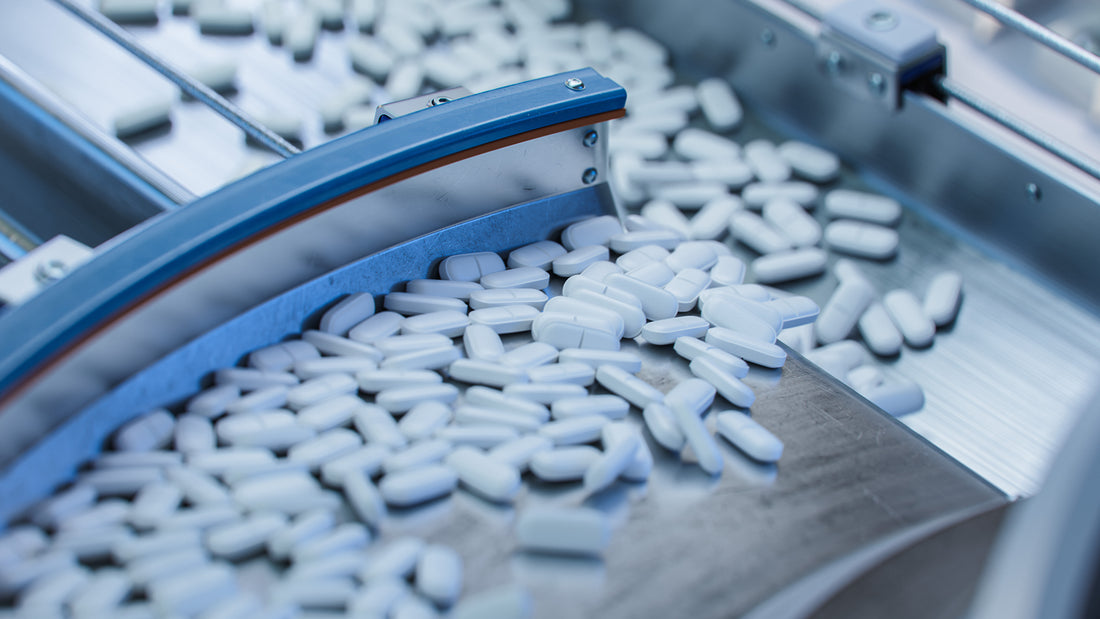This article outlines key tasks in the process of creating a comprehensive contamination control strategy for GMP manufacturing.
Designing a comprehensive contamination control strategy for a new pharmaceutical manufacturing plant is a multifaceted task that involves careful planning, implementation, and ongoing monitoring. The following is a generalized outline that you can use as a starting point for developing a contamination control strategy. Keep in mind that the specific details will vary based on the type of pharmaceuticals being manufactured and regulatory requirements.
The European GMP standard has recently been updated with new Annex 1, regarding the manufacture of sterile products. We will have a separate article on the implications of the new Annex 1 soon.
- To read how the automatic, touch-free blue light disinfection will help you maintain high hygienic level in personnel cut-off rooms and material airlocks, please see our section about cleanroom decontamination.
Contamination Control Strategy
1. Introduction
- Provide an overview of the pharmaceutical manufacturing plant, including its purpose, scale, and the types of products to be produced.
- Emphasize the critical importance of contamination control in pharmaceutical manufacturing.
2. Regulatory Compliance
- Detail the relevant regulatory requirements for pharmaceutical manufacturing in the geographical location of the plant (e.g., FDA regulations in the United States, EMA regulations in the European Union).
- Outline how the contamination control strategy aligns with and exceeds these regulations.
3. Facility Design and Layout
- Describe the cleanroom design, including the classification and specifications of each cleanroom area.
- Emphasize the use of principles such as unidirectional airflow, proper HVAC systems, and effective facility layout to minimize the risk of contamination.
4. Personnel Training and Hygiene
- Outline a comprehensive training program for all personnel entering cleanroom areas.
- Detail the proper gowning procedures, hygiene practices, and ongoing training initiatives to maintain a culture of cleanliness.
5. Environmental Monitoring
- Implement a robust environmental monitoring program, including particle counting, microbial monitoring, and temperature/humidity control.
- Define action and alert limits and establish procedures for responding to excursions.
6. Equipment Design and Maintenance
- Specify equipment design criteria to prevent contamination and allow for easy cleaning and maintenance.
- Develop a preventive maintenance schedule for all equipment, ensuring that it complies with regulatory requirements.
7. Material Control
- Establish stringent material control procedures, including the inspection and testing of raw materials.
- Implement a comprehensive supplier qualification program to ensure the quality of incoming materials.
8. Cleaning and Disinfection Procedures
- Detail cleaning and disinfection protocols for each cleanroom area, specifying cleaning agents, frequencies, and methods.
- Conduct regular validation of cleaning procedures to ensure their effectiveness.
9. Cross-Contamination Prevention
- Develop protocols for preventing cross-contamination between different manufacturing processes.
- Implement physical and procedural controls to minimize the risk of contamination during product changeovers.
10. Documentation and Record Keeping
- Establish a robust documentation system for contamination control procedures, including batch records, cleaning logs, and environmental monitoring data.
- Implement an electronic document management system to facilitate accessibility and traceability.
11. Ongoing Monitoring and Continuous Improvement
- Define a program for ongoing monitoring and regular audits to assess the effectiveness of the contamination control strategy.
- Establish mechanisms for continuous improvement, incorporating feedback from deviations, incidents, and regulatory inspections.
12. Emergency Response and Contingency Planning
- Develop contingency plans for responding to contamination incidents or deviations from established procedures.
- Outline procedures for investigation, root cause analysis, and corrective and preventive actions (CAPA).
Conclusion about creating a contamination control strategy
- Summarize the key elements of the contamination control strategy.
- Emphasize the commitment to maintaining the highest standards of cleanliness and product quality.
This outline is a starting point, and you should tailor it to the specific requirements of your pharmaceutical manufacturing plant, considering the nature of the products, the facility's design, and the applicable regulatory landscape. Always consult with regulatory experts and consider industry best practices when developing and implementing your contamination control strategy.
Further guidance:
For more specific and detailed information, as well as the latest developments in pharmaceutical cleanroom practices, we recommend consulting authoritative sources such as regulatory guidelines, research articles, and publications from reputable organizations. Here are some potential sources to explore:
-
Regulatory Guidelines:
- FDA (U.S. Food and Drug Administration) - Guidance for Industry documents.
- EMA (European Medicines Agency) - Guidelines on Good Manufacturing Practice (GMP).
-
Industry Publications:
- Publications from pharmaceutical industry associations such as ISPE (International Society for Pharmaceutical Engineering).
- Journals specializing in pharmaceutical science and manufacturing.
-
Textbooks and Reference Materials:
- Textbooks on pharmaceutical manufacturing, cleanroom design, and contamination control.
- Textbooks on pharmaceutical manufacturing, cleanroom design, and contamination control.
-
Research Articles:
- Peer-reviewed articles from scientific journals focusing on pharmaceutical manufacturing and cleanroom technology.
- Peer-reviewed articles from scientific journals focusing on pharmaceutical manufacturing and cleanroom technology.
-
Cleanroom Standards:
- ISO (International Organization for Standardization) standards related to cleanrooms and associated controlled environments.
Related articles:

